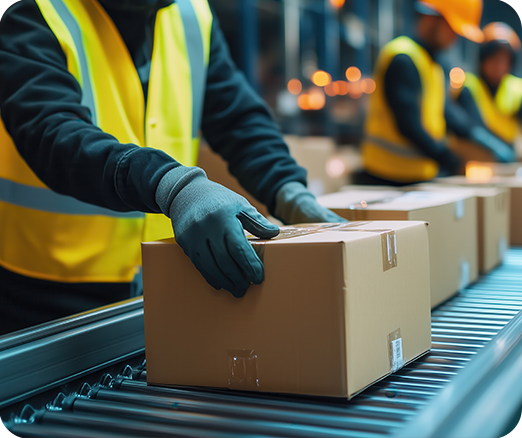
Data-Driven Strategies to Minimize Backorders for Retail Success
For both consumer brands and retailers, it is crucial to understand the causes and effects of backorders, and more importantly, to know how to prevent or minimize them in order to maintain sales, brand loyalty, and brand reputation.
Backorders can be a double-edged sword. On the one hand, backorders can create excitement in the market, indicating high demand for a product, making it popular and worthy of purchase. On the other hand, backorders can indicate inventory management problems with the supplier or the retailer, or larger supply chain issues. If product fulfillment delays are too long or too frequent, they can be a disadvantage to both parties. Furthermore, managing backorders can be a major headache for a consumer packaged goods (CPG) company’s finance and logistics teams.
Either way, backorders can be tricky to manage and make or break a company’s success. If a purchase or order cannot be fulfilled promptly, whether in-store or online, the customer may become more irritated than if the item had simply been marked as out of stock or unavailable. Therefore, being able to prevent or limit backorders is key to keeping shoppers satisfied so they keep buying from you and your retailer partners.
Knowing the distinction between backorders and out-of-stock items and how to effectively manage the advantages and disadvantages of backorders by leveraging reliable retail data is vital to establishing business processes and strategies that best suit your needs.
This blog post explores how CPG companies and retailers can use accurate daily data to minimize or avoid backorders, enhance inventory management, and improve overall operational efficiency and customer satisfaction.
WHAT IS A BACKORDER?
Ideally, a business will always have enough products available to meet customer demand. In reality, though, for both physical stores and e-commerce websites, that isn’t always the case. As a result, a backorder may be generated.
A backorder, also known as a backlog, is created when an order cannot be fulfilled at the time of purchase (in-store or online) because the item is not in the seller’s current inventory; however, the item is still in production and will be available in the future.
Backorders indicate that consumer demand for a given product exceeds what the seller (CPG or retailer) produced, ordered, or has available. This could be a function of poor planning, production issues, inadequate retailer-supplier communication and collaboration, supply chain issues, overly strict safety stock policies, or an unforeseeable spike in consumer demand for a product.
A backorder can take weeks or even months to fulfill, depending on the cause of insufficient stock and the product. If a retailer runs out of an item temporarily, they may offer customers the option to accept backorders in the interim, and in turn, take the customer’s payment details to guarantee the product’s delivery to the buyer as soon as the product is available.
What’s the Difference Between Backorder and Out-of-Stock?
Both terms—backorder and out of stock—refer to situations where a product is unavailable for immediate purchase, but there is a clear distinction between the two.
When a product is on backorder, it means that the seller expects to receive more inventory within a reasonable time frame and will fulfill customer orders at a later date. Customers who have placed an item on backorder can expect their order to be shipped or available for pickup when the business restocks. In simple terms, the item is facing a temporary shortage, and the delivery is only delayed.
Conversely, when an item is labeled as out of stock, it means the seller does not have the product in inventory and does not have an official restocking date. Out-of-stock situations can occur due to various reasons, making it challenging for businesses to predict when they will have the product available to fulfill orders. Additionally, the item may be seasonal or produced in limited quantities. In some cases, the out-of-stock item may not be manufactured anymore and will never be available for purchase again.
In summary, with a backorder, the product is temporarily unavailable, while an out-of-stock item may be permanently unavailable. The key difference between these two scenarios lies in how retailers and suppliers communicate with customers about product availability and delivery times: accepting backorders allows them greater flexibility in managing their products and supply chain while providing transparency about expected fulfillment dates. On the other hand, labeling products as “out of stock” leaves customers in a gray area—uncertain about whether they should wait for the product or search for that item or similar items elsewhere.
"The causes of backorders can vary, similar to out-of-stocks, but understanding the root causes of backorders can help companies take steps to reduce or eliminate them."
Backorders, as opposed to out-of-stocks, can be a deliberate part of a seller’s marketing strategy. This is because the seller can share information about expected restocking and delivery dates, shipping and return policies, and various customer service details. By doing so, they can encourage brand and store loyalty, and help retain customers, preventing them from buying from a competitor or another brick-and-mortar store or e-commerce business.
Backorders, though, can pose a financial burden for companies; therefore, it is crucial to understand what they are and how to prevent or mitigate them. The causes of backorders can vary, similar to out-of-stocks, but understanding the root causes of backorders can help companies take the proper steps to reduce or eliminate them.
6 common causes of backorders
There are various internal and external factors that can cause backorders, some of which are preventable and others that are out of your control. The first step in preventing or minimizing backorders is to identify and address their causes.
Here are six of the more common reasons for backorders:
1. Sudden Increase or Fluctuations in Demand:
Sudden and unexpected increases in demand for a product can result in backorders if a business is unable to quickly react and adjust inventory levels. Unusual purchasing patterns can occur due to holiday seasons or seasonal fluctuations, popular marketing or promotional campaigns (e.g., new product launches), or unexpected events such as extreme weather (e.g., hurricanes and heat waves) or a pandemic (like the coronavirus and the rush for toilet paper!).
Both CPG companies and retailers should closely monitor consumer trends, market conditions, and shopper preferences to anticipate fluctuations in consumer demand and prevent stockouts.
2. Inaccurate Demand Forecasting:
Less accurate forecasting can lead to lower safety stock levels and an increased chance of backorders. Additionally, if a product's safety stock is not set or counted correctly, sellers may experience backorders due to insufficient stock levels, even for regular demand.
3. Supplier/Manufacturer Issues and Supply Chain Disruptions:
As the COVID-19 pandemic showed us, supply chain disruptions can happen quickly and hit brands and retailers hard, leading to out-of-stock products, significant delays in product delivery, and backorders. In other instances, backorders can be a result of a supplier going out of business, unexpected production issues such as equipment failure, raw materials shortage, factory shutdowns, and even labor disputes.
These supplier/manufacturer and supply chain issues can delay production, transportation, and delivery of goods, thus, negatively affecting a seller’s ability to fulfill orders on time and meet consumer demand.
4. Long Lead Times / Delayed Orders:
Retailers and e-commerce businesses that consistently place timely product reorders may still encounter backorders due to inconsistent lead times from manufacturers or suppliers. This variability could be caused by supply chain disruptions or the supplier failing to replenish their usual stock.
Companies that order products using safety stock calculations and conduct manual purchase order reviews may also face delays in replenishment. This could lead to the depletion of their safety stock, resulting in items being put on backorder.
5. Human Error:
Like any business, mistakes can occur. For example, an employee might mistakenly enter an order as a backorder when the item is actually in stock. Conversely, they might create a backorder for an item that is officially out of stock. Forgetfulness can also lead to issues such as overselling inventory due to a failure to replenish products on time or remove out-of-stock items from their website.
6. Inaccurate Inventory Management and Warehouse Management Discrepancies:
Sellers require timely and accurate data regarding inventory levels to determine when to reorder products before running out of stock. However, managing a warehouse involves multiple processes, and with so much activity occurring in a warehouse, it is easy to lose track of inventory.
Miscounted or misplaced inventory could lead to excess inventory for some items while leaving others unavailable for customers who want them. Failure to notice missing, expired, or damaged inventory could result in selling inventory that is not actually in stock. Inadequate inventory management systems can also contribute to backorders if they experience glitches, provide incorrect data about stock levels, or if data entry is not performed properly.
UNDERSTANDING THE IMPACT OF BACKORDERS
Before delving into data-driven strategies to prevent backorders, it's important to comprehend their impact on a retailer or CPG business. Here are several ways in which backorders can be harmful to your business.
Customer Dissatisfaction and Loss of Customers:
When a customer places an order, they expect to receive the product in a reasonable amount of time. However, backorders can cause delays in fulfilling orders, leading to frustrated customers who may choose to shop elsewhere for the product they want—or not buy your products ever again. Unhappy customers may also leave negative reviews that can impact your brand reputation and future orders.
Lost Sales:
If your products are frequently on backorder, customers may not want to wait or trust the company to fulfill their orders, causing them to cancel. E-commerce customers who are accustomed to 2-day shipping may not be willing to wait for an item to be replenished. As a result, they could purchase a competitor’s product that is readily available, leading to lost sales and revenue.
Increased Operational Costs:
Managing backorders involves additional administrative work and communication with customers, increasing operational costs.
Negative Brand Perception:
Consistent backorder issues can damage the reputation of a retailer or CPG company, making it more difficult to attract and retain customers and maintain brand loyalty.
Loss of Market Share:
If customers regularly encounter backorders or experience long wait times for order fulfillment, their support and loyalty to your brand may diminish, and customers could seek out other retailers and brands.
Increased Resources Usage:
When backorders occur, a business typically ends up using extra resources to rectify the situation. For instance, the business may need to expend more effort to notify customers about their backordered purchases, pay for expedited shipping from their supplier or manufacturer to prevent canceled orders, or allocate additional time to quickly fulfill and ship customer orders once inventory is replenished.
By using high-quality retail data to address these challenges, brands and retailers can optimize their inventory levels and management, enhance customer satisfaction, and ultimately drive mutual business growth.
THE ROLE OF precise, DAILY DATA IN REDUCING BACKORDERS
Data plays a crucial role in anticipating consumer demand, optimizing inventory, and streamlining operations. However, brands and retailers will find it much harder to meet their sales and revenue goals and maximize efficiencies without clean, harmonized daily item- and store-level point-of-sale (POS) and inventory data.
This granular data, especially when integrated with syndicated and third-party data (e.g., weather and social media), enables businesses to derive timely and meaningful insights. These insights can be utilized across a CPG's enterprise and within the supplier-retailer relationship to make more informed, collaborative strategic decisions that move the needle in a positive direction.
Here are five key strategies to reduce backorders using near real-time retail data:
1. Sales Forecasting and Demand Forecasting
Accurate demand forecasting is the foundation of effective inventory management. By analyzing granular historical sales data, market trends, and seasonality, sellers can predict future demand more accurately and confidently. Advanced analytics tools and machine learning algorithms can process vast amounts of data to identify patterns and generate reliable forecasts. However, those applications will be significantly more reliable for optimal decision-making when using daily POS and inventory data as the base layer.
Steps to Improve Demand Forecasting:
- Collect Comprehensive Data: Automatically collect and integrate data from various retail data sources, including sales records, customer feedback, and market trends.
- Use Advanced Analytics: Implement machine learning algorithms to analyze data and generate accurate demand forecasts.
- Regularly Update Forecasts: Continuously update forecasts based on the latest POS and inventory data at the most detailed level (SKU-store) to account for changes in market conditions and consumer behavior.
2. Inventory Optimization
Optimizing inventory levels is crucial for minimizing backorders and ensuring timely product delivery to customers. Businesses must find the right balance in maintaining adequate stock levels to meet customer demand without holding excess inventory. This is vital because excess inventory ties up capital, leads to higher carrying costs, and may result in having to sell products at a discount. Data-driven inventory optimization involves analyzing daily sales data, lead times, and supplier performance (for retailers) to determine the most effective stock levels.
Techniques for Inventory Optimization:
- ABC Analysis: Classify inventory into categories (A, B, and C) based on their importance and sales volume. Focus on ensuring high availability for category A items.
- Safety Stock Calculation: Use statistical methods based on daily retail data and accurate historical sales data to calculate the appropriate level of safety stock to buffer against demand variability and supply chain disruptions.
- Just-In-Time (JIT) Inventory: Implement JIT practices to reduce excess inventory and ensure that products are available when needed.
3. Supplier-Retailer Collaboration
Effective collaboration between suppliers and their retailer partners is essential for maintaining an efficient and reliable supply chain, ensuring products are readily available for sale. By sharing sales forecasts, demand forecasts, promotional plans, and inventory data with each other, retailers can improve lead times and reduce the risk of stockouts.
Strategies for Supplier-Retailer Collaboration:
- Data Sharing: Retailers share near real-time POS and inventory data with suppliers to enable better planning and coordination.
- Performance Monitoring: Use enhanced data analytics to monitor product, store, trade promotion, and new product performance, including sales, lead times, order accuracy, and reliability.
- Collaborative Planning: Engage in frequent collaborative planning, forecasting, and replenishment (CPFR) initiatives to align on demand and supply plans.
4. Real-Time Inventory Tracking
Near real-time inventory tracking provides enhanced visibility into stock levels across all locations, including warehouses and stores. This visibility helps brands and retailers respond promptly to shifts in consumer demand or market conditions and make better-informed decisions about inventory allocation and replenishment. With the right technology, sellers should be able to receive automatic alerts when a product is at risk of being out-of-stock.
Benefits of Near Real-Time Inventory Tracking:
- Improved Accuracy: Reduce discrepancies between actual and recorded inventory levels.
- Faster Response: Quickly identify and address stockouts or overstock situations.
- Enhanced Customer Experience: Provide customers with accurate information about product availability, reducing the likelihood of backorders, frustrated shoppers, or lost sales.
5. Customer Data Analysis
Understanding customer behavior and preferences can help sellers anticipate demand and reduce backorders. Analyzing customer data, such as purchase history and browsing behavior, provides insights into which products are likely to be in high demand.
Methods for Customer Data Analysis:
- Segmentation: Segment customers based on their purchasing behavior and preferences to tailor inventory levels to different segments.
- Predictive Analytics: Use predictive analytics to identify trends and forecast future demand based on customer behavior patterns.
- Personalization: Implement personalized marketing and recommendations to influence customer demand and manage inventory effectively.
"Reducing backorders requires a proactive approach by multiple stakeholders who collaboratively use reliable near real-time POS and inventory data to gain actionable insights."
Conclusion
Understanding the causes and impact of backorders is essential for businesses to effectively manage their inventory levels and consistently meet consumer demand. This is especially important when demand is unpredictable or there are supply chain disruptions. When products are readily available and sellers can fulfill orders in an appropriate time frame, they increase their odds of improving customer satisfaction and retention, brand loyalty, and sales.
Reducing backorders requires a proactive approach by multiple stakeholders who collaboratively use reliable near real-time POS and inventory data, as well as detailed historical data, to gain actionable insights. This enables them to optimize inventory management, accurately set reorder points and safety stock, and improve operational efficiency.
Activating daily SKU- and store-level retail data that is seamlessly integrated with ERP and third-party data using a modern retail data platform like VELOCITY® empowers suppliers and retailers to implement data-driven strategies such as demand forecasting, inventory optimization, supplier-retailer collaboration, real-time inventory tracking, and customer data analysis to minimize backorders.
For 30 years, Retail Velocity has helped brands gain granular visibility into daily sales and inventory positions to anticipate consumer demand more accurately, optimize inventory for on-shelf availability and order fulfillment, and improve supply chain strategies and collaboration to ensure shoppers can purchase the products they want when they want them.
Schedule a consultation to discover how our VELOCITY® platform can automatically collect and provide you with precise retail data to minimize backorders and maximize sales, revenue, and profitability.



